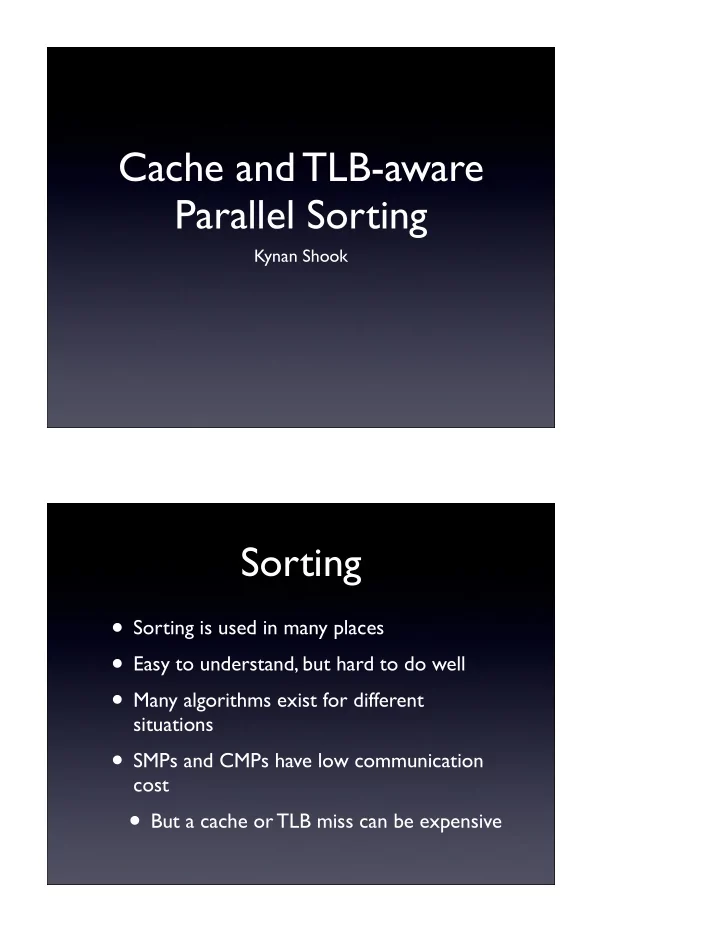

Cache and TLB-aware Parallel Sorting Kynan Shook Sorting • Sorting is used in many places • Easy to understand, but hard to do well • Many algorithms exist for different situations • SMPs and CMPs have low communication cost • But a cache or TLB miss can be expensive
Techniques • Baseline is a sorting program from last year • Profile the code • Modify the algorithms to improve locality • Port from Objective-C to C, and test on other platforms Radix Sort 101 • Look at one “digit” at a time (8 bits) • Parallel radix sort uses counting sort locally • Counts frequency of each digit in parallel • Computes offset in destination array for each digit • Shuffles data; read in order, write to one of 256 locations
Improving Locality #1 • Only count a subset of digits at once • Reduce random access • Array of counts • Destinations in data array • Requires looping through input more times Segmented Sorting • Result was a significant slowdown • Buckets easily fit in cache • Improves write locality slightly • Significantly increases amount of work
Reducing the Radix • Similar to previous technique • Count array is smaller • Possible destinations are fewer • More iterations are required • Requires barriers between iterations • Reduces memory used Improving Locality #2 • Data shuffle phase is hard on cache and TLB • Moving data takes 3x to 16x longer than counting sort phase • IPC while counting is 3x to 13x higher than while moving data • Try bucket sort instead of counting sort
Bucket Sort • Bucket sort divides data into buckets • Result is a concatenation of all buckets • Still requires a random write • Overhead turns out to be higher • Extra copy to move data back to array • Buckets need to be resized dynamically Improving Locality #3 • Single-threaded radix sort can count all digits in first iteration • Multi-threaded radix sort must wait at least until shuffle step • Increment destination’s count array while shuffling • Increases the working set size
Generic Optimizations • Avoiding globals • Make a new local copy after global has changed • Using appropriate locking libraries • Reducing library calls Results • 4 times fewer TLB misses • 94% are while sorting; originally 60% • L2 total misses are 10% lower • Miss rate is 40% higher • L1 total misses are 20% lower • Miss rate is 30% higher
Port from Objective-C • Replace Cocoa Threads with pthreads • Replace NSConditionLock with pthread mutex and pthread condition variable • Otherwise, very similar • Objective-C is a strict superset of C • Original code didn’t have many objects, so there were few changes to make Objective-C versus C • Surprisingly, Objective-C version ran faster than C version • Code is nearly identical • C version has higher TLB miss rate
Best Performance • Chianti: 1.88 seconds, 13.6x parallel speedup (32 threads) • Clover: 2.49 seconds, 5.6x parallel speedup (8 threads) • Dual PowerPC G5: 1.74 seconds, 1.3x parallel speedup (2 threads) Initial TLB miss rate 0.004 0.003 0.002 0.001 0 Time
Final TLB miss rate 0.004 0.003 0.002 0.001 0 Time Conclusions • Can significantly improve TLB and cache performance without modifying algorithms • Profiling different events can yield a wide variety of information • It can be hard to judge cause and effect on real hardware
Recommend
More recommend